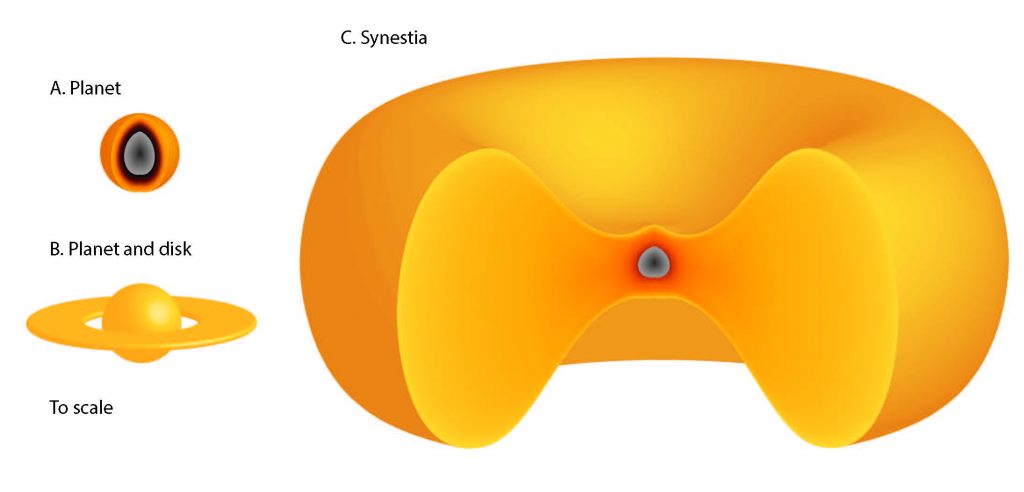Hot-Donut Earth? Planet May Once Have Taken on Odd 'Synestia' Form

Earth probably became a "synestia" for a brief period about 4.5 billion years ago, according to a new study.
That's the term for a newly proposed cosmic object: a huge, hot, donut-shaped mass of vaporized rock that results from the collision of two planet-size bodies.
Astronomers think Earth endured such an impact shortly after the planet's birth, slamming into a Mars-size object known as Theia. (This smashup — or series of smashups, as one recent study posits — also resulted in the creation of Earth's moon, scientists believe.)
"We looked at the statistics of giant impacts, and we found that they can form a completely new structure," study co-author Sarah Stewart, a planetary scientist at the University of California, Davis, said in a statement.
Stewart and lead author Simon Lock, a graduate student at Harvard University, modeled what happens when rocky worlds about the size of Earth crash into other large bodies that are moving, and spinning, relatively fast. The researchers' simulations suggest that the most violent encounters would produce synestias, putative structures that look like gigantic red blood cells.
Previous studies have posited that such impacts might produce a debris ring around a planet. But a synestia is a far bigger and weirder object; it is made mostly of vaporized rock and has no solid or liquid surface, Lock and Stewart said. (The name synestia, incidentally, comes from "syn," Greek for "together," and "Estia," the Greek goddess of structures and architecture.)
Synestias — if they exist — are short-lived objects. Earth likely stayed in the synestia phase for just a century or so after the collision with Theia, according to the new study. The synestia-Earth then lost enough heat to condense back into a solid object, the thinking goes.
Get the Space.com Newsletter
Breaking space news, the latest updates on rocket launches, skywatching events and more!
At the moment, synestias are hypothetical objects; nobody has ever seen one. But astronomers may be able to spot them in alien solar systems, Stewart said.
The new study was published online today (May 22) in the Journal of Geophysical Research: Planets.
Follow Mike Wall on Twitter @michaeldwall and Google+. Follow us @Spacedotcom, Facebook or Google+. Originally published on Space.com.
Join our Space Forums to keep talking space on the latest missions, night sky and more! And if you have a news tip, correction or comment, let us know at: community@space.com.

Michael Wall is a Senior Space Writer with Space.com and joined the team in 2010. He primarily covers exoplanets, spaceflight and military space, but has been known to dabble in the space art beat. His book about the search for alien life, "Out There," was published on Nov. 13, 2018. Before becoming a science writer, Michael worked as a herpetologist and wildlife biologist. He has a Ph.D. in evolutionary biology from the University of Sydney, Australia, a bachelor's degree from the University of Arizona, and a graduate certificate in science writing from the University of California, Santa Cruz. To find out what his latest project is, you can follow Michael on Twitter.
Most Popular
